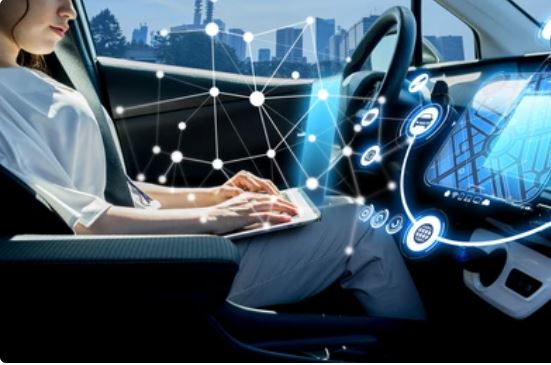The Future of Autonomous Vehicles in India
INTRODUCTION
NHTSA in one of its concluding reports held that its mostly the human choice or error that forms the crude margin of accidents on highways, amounting to as high as 94%.[1]

When Mahindra launched the XUV700 with autonomous driving features in India last year, there was a huge uproar in the Indian car market. The driving assistance tech which seemed to be reserved for the luxury segment seemed a bit affordable for the masses.[2] The advent of cars like MG Gloster, Astor, Volvo XC40 and Mahindra XUV700 mark the era of a new type of automobile commute in India, known as autonomous driving. However, the word in itself connotates a very different meaning that what it should be. Autonomous refers to acting and governing alone in accordance to state of play in hand while the correct term for the usage should be automated; control by the equipment in the process.[3] Albeit, it was only chosen as it was simpler for the public to understand autonomous rather than automated. It is interesting to note that European legislations like Britain have clearly included the meanings of such vehicles in their acts.[4] But no such attempt has been seen in India even though motor vehicles amendment act was passed just a year later.[5] With a dim light on the subject matter of laws of autonomous cars, it becomes imperative to discuss certain aspects in relation to autonomous cars. These vehicles are filled with class leading technologies to aid the driver in long cross-country trips and also in cities where they are prone to hitting the two-wheeler counterparts.[6] Some of the technologies include blind spot monitoring system, which is termed differently by various companies. Volvo likes to call this system BLIS or Blind Spot Information System.[7] It helps people in detecting if or not a vehicle is in their blind spot to avoid accidental takeovers. Other systems like Lane watch systems (which steer the vehicle back into a lane when the driver decides to become negligent and let the car move out of the lane) and Autonomous braking systems (which automatically stop a vehicle in the case that the driver fails to react quickly to the situation of emergency braking) also do their jobs in justifying the autonomous tech. However, all these technologies have a variation in terms of the level of autonomy they offer. All the autonomous vehicles don’t have the same level of features or driverless tech which may help the car to drive on their own. They are classified based on the worldwide acclaimed standards of autonomous levels which are classified based on the ability of the car to drive without requiring driver supervision in certain circumstances. While these levels range all the way from Level 0 to Level 5 (Level 0 meaning no form of driver aid tech and Level 5 meaning when the car is fully capable of driving without human intervention)[8], all of these levels have been taken into consideration with respect to European and American roads and driver habits. The implementation of such levels can’t be matched to the chaotic situation of Asian countries where big population and small roads conform the drivers to peruse into rule breaking methods to reach the destination on time. Thus, various steering movements and driver habits are not taken into account in these levels. It is in account of these simple variations that Indian autonomous vehicle buyers may ask themselves, “If the Legislation isn’t ready with apt rules and regulations for these vehicles, are we ready to take heed of the risk associated with it and buy it?”
TORTIOUS CLAIMS AND ASSOCIATION OF LIABILITY IN THE CASE OF AUTONOMOUS VEHICLES
The concept of strict and absolute liability[9] is not a new alibi to the show of tortious claims. They have serving as faithful precedents for the subjugation of justice for a long period of time. However, it is time for us to bring the autonomous vehicles under the same cold blanket of responsibility with these liabilities. The crude question to be imposed on the legislation is, “Who bears the utmost responsibility or liability in case of accident of autonomous vehicles where the driver was not at a fault?”
From a rationale viewpoint, a manufacturer should be held strictly liable for any such accidents, since it can be argued that a more knowledgeable vantage point of a manufacturer for knowing these ultrahazardous activities of his product make him the bearer of associated costs.[10] Even the Motor Vehicles act opt for a ‘no fault’ liability in the case of permanent death or disability arising out of the actions of the driver.[11] But these manufacturers are rarely prosecuted for such faults in machines[12]. However, this imposes a very interesting dilemma for the Indian legislation. On one hand, they have to promote the use of more autonomous vehicles for making the roads safer from the error of human choice by encouraging manufacturers and limiting liability, while on the other hand they also have to keep the principle of general public welfare in mind. Another thing that has to be paid attention to is the bungling delays in adoption of such technology that raises proportionally as the manufacturer’s liability increases. This makes the manufacturer more hesitant than ever. Another problem that paves the way for difficult codification of rules for automated vehicles is the idea of consent involved with using such technologies. The idea of consent is conveyed through an interactive digital SmartScreen like the AUDI MMI[13] or TESLA SMART TABLET[14] on the dashboard. It acts as a mechanism to transfer the liability of crashes from the Automated vehicle and behest it to the driver as he duly consents to the risks involved and promises to be vigilant to the road conditions as well. The argument that is generated from such usage patterns pertains to the idea of ‘Volenti Non-Fit Injuria’. However, it is sufficient to note that the driver may not appreciate the risk and legal obligations involved with such technology or would not have much training and education.[15]
US holds that robots can’t be prosecuted for their mistakes and the manufacturer is the sole culprit here.[16]If a strict contrast is taken towards Section 2 (34) of the Consumer Protection Act 2019[17] on the matters of product liability, it provides that the manufacturer would be liable for defects in the product or the deficiency in his services. He is also liable to provide for compensation arising due to such deficiencies for the harm caused. Thus, if the AI used for the process of autonomous driving is considered a full-fledged product of the manufacturer (it is an option for many cars in a package[18], then consumer act provides them to be responsible in the cases of accidents. The factor of habit-oriented AI systems is also to be taken into the consideration in the working of such AI systems. If an Indian owner is in a habit to run a redlight and the car learns from the driver’s driving behaviour, would the car enact the same way in autonomous mode to connect to driving profile of the owner/driver even if the driver did not want the car to do so? In such cases it is important to provide for safeguards to ignore bad habits.
Cases like that of Haji Zakaria[19] have tried to get a settlement on the question of liability by keeping to the opinion of holding the manufacturer liable if there was no presence of rash or negligent behaviour on the driver’s side. If this is applied to autonomous vehicles, then the manufactures would be liable every time. Manufacturers around the world have taken up the issue of responsibility by engaging in pledge-based ideals and further disseminating the ideas to promote the use of autonomous vehicles. Companies like Volvo, Google and Mercedes- Benz had vowed to be fully liable in cases of accidents arising out of their Autonomous driving abled vehicles.[20] The main contention that arises out of such pledges is their actual legal value in the eyes of law. These pledges serve as good promotional tools for the manufacturers but mere word value instead of action value might deter potential buyers and legislation from actual adoption.
In conclusion, a specifically tailored act suitable for the incubation of autonomous vehicles into the Indian market has to be enacted keeping in mind various Indian scenarios. Strict liability should be imposed on faulty electrical hardware or programming error bugs that are subject to third party hacking[21]. Alongside, a clear provision should be provided to help make the driver liable if he decides to share the credentials of the autonomous car allowing it to be remotely controlled, say from the tesla app itself.[22] The act should also provide for mandatory safety warning safety systems or a safe kill switch for the driver to take over. Lastly, the government should also incentivize the automobile manufacturers to go for compulsory insurance for tortious claims in the case of accidents by autonomous vehicles which should make them future litigation ready.[23]
INTEGRATION OF CLAUSES REGARDING AUTONOMOUS VEHICLES TO WORK IN CONJUNCTION WITH OBJECTIVES OF RIGHT TO DISABILITIES ACT,2016.
Section 41[24] of the Right to Disabilities Act, 2016 says that—
The appropriate Government shall take suitable measures to provide, — (a) facilities for persons with disabilities at bus stops, railway stations and airports conforming to the accessibility standards relating to parking spaces, toilets, ticketing counters and ticketing machines;
(b) access to all modes of transport that conform the design standards, including retrofitting old modes of transport, wherever technically feasible and safe for persons with disabilities, economically viable and without entailing major structural changes in design;
(c) accessible roads to address mobility necessary for persons with disabilities.
(2) The appropriate Government shall develop schemes programmes to promote the personal mobility of persons with disabilities at affordable cost to provide for, —
(a) incentives and concessions; (b) retrofitting of vehicles; and (c) personal mobility assistance.
All of the clauses in the right to disabilities act can conform to autonomous vehicles providing ease of transportation for the disabled. If the government incentivises the manufacturers to promote driverless tech and also allows for taxi companies to start driverless taxis it can help in making cars a popular transit for blind, paralysed or other people with disabilities. This helps in achieving the objectives laid out in Section 41 of the act.
Companies already use technologies like Tesla AUTOPILOT[25], GM’s Cadillac SUPERCRUISE[26] (applicable on certain highways), Mercedes’ ADVANCED DISTRONIC PLUS SYSTEMS[27] and Volvo’s INTELLISAFE AUTOPILOT[28] to promote such driverless techniques without intervention of humans at certain places.
Although these systems help the person to become hands and feet free, one of the things that any passenger has to keep in mind that these technologies don’t make it mind free for the passenger or the driver. One of the ways legislation can help the disabled in the society is to incorporate the objectives of section 41 into a bill for such autonomous vehicles into the future and help in promotion of such vehicles. It shall help to provide the disabled with the right to move and healthy transit and an affordable cost. This also means that people can retrofit their vehicles using LI-DAR technologies to benefit from the ease of transportation that these offer.[29]
IS RIGHT TO PRIVACY VIOLATED UNDER SUCH AUTONOMOUS VEHICLES (PRIVACY BY DESIGN PRINCIPLE)
Autonomous vehicle levels have a very contentious issue at hand. They do not summarize the part of the driver in the usage of such vehicles; in the sense that they do not properly figure out the job of the driver at capricious levels of autonomous driving.[30] Article 21 of our constitution guarantees right to privacy under the sublet of right to protection of life and personal liberty.[31] Millions of lines of software care operate the onboard support systems, which is even less than a Boeing airplane.[32] As the sale of such technology in cars gain momentum, it is important to foster the trust in a consumer’s mind so that he makes the decision without being vexed by the privacy implications it holds.
These vehicles generate a lot of user data about their owners and the driver. It constantly monitors the driver to adapt to his driving styles. For this usage, it uses inbuilt dashboard cameras and sensors which help in monitoring driving fatigue and concentration.[33] These sensors are bound to collect and analyse the data stored offline on computers or sent back to the data to improve the driving aid technology. In conjunction, these vehicles also create user advertising profiles based on individual travel habits and patterns derived from everyday driving. These can be linked to their Internet browsing history, patterns and usage information alongside other potential browsing data to generate advertising information.[34]
Mainly there is a dire need to take care of three types of privacy that is embedded into a human’s life; Personal autonomy, Personal Information and Surveillance.[35] All of these should be varied privacy interests that should be kept in mind while creating the software needed for these cars by creating specific legislation sections so that article 21 is not violated. Here the major concerns relate to invasion of privacy by tracking devices that are placed in all these smart cars to give back information to the authority letting them track the user without issuing a warrant. In the US, we already have Driver’s Privacy Protection act and precedents like the Jones case[36] which incorporate the ideas of privacy that a driver has with regards to his driving patterns and personal information processed. The same preoccupying nature of article 21 in our country is neither seen in the motor vehicles act nor any specific law.
A way through which we can implement this is the privacy by design principle.[37] The privacy by design principle will help in bringing confidence among the people to adopt the ADAS features. It will help in eliminating market resistance. The privacy by design principle asks the manufacturer to make products keeping privacy in the forefront. If the product was made keeping in mind the privacy concerns of the user, it would not be very hard to update their terms and software each time a new privacy concern is raised. On the contrary, if the product doesn’t imbibe privacy in the beginning development stages, it sometimes becomes very hard to operate such machines without first violating privacy concerns.
SUGGESTIONS IN THE MAKING OF AUTONOMOUS LAWS THROUGH A GLOBAL CONTRAST(CONCLUSION)
The Indian Road conditions and driver habits aren’t like their European and American counterparts. The current autonomous tech is created in developed countries keeping only their roads and driving habits in mind. It creates a problem for the Indian manufacturer to develop a tailored system made for Indian conditions. Thus, a consensus should be decided so that either the international standards are officially accepted or the MORTH (Ministry of Road Transport and Highway) needs to take matters in their own hand to develop Bharat standard levels in relation to autonomous driving. It is essential to advise MORTH to look to its NHTSA brother in high standards and get inspired. Another key roadblock to the future of these vehicles is the poor road and transport infrastructure. These vehicles operate in a pot free and smooth tarmac environment. The government should allow the use of such vehicles only in specific highway sections and certain city roads to prevent unwanted accidents.
The second much needed change is with relation to hacking and interconnectivity. There is a need to oversee the communications network of these vehicles with each other. These vehicles have the ability to communicate with each other through a common company network. Not only this but certain manufacturers have gained the ability to communicate with traffic signals to make the car move in a certain way to reach destination with all lights green.[38] However, this connected car tech also involves potential car hacking and traffic signal manipulation which can be a cause for a malicious traffic jam. Thus, standardized encryption standards with state-of-the-art protocols like AES-256 are a need of the hour to protect innocent buyers and government agencies using such vehicles from being hacked.[39] Specific provisions in relation to hacking of autonomous vehicles need to be enlisted in IT act, 2000[40] too.
Autonomous vehicle components also need specific components to make sure that the car can observe the environment correctly. Thus, specific standards for autonomous tech need to be established for uniform performance of cars across all highways. Another alternative that can be considered with manufacture advise and implementation is the retrofitting of old cars with autonomous tech. The government should incentivise such retrofitting (similar to CNG technology) by reduction in insurance or by bringing in subsidy. It makes the vehicles comparatively safer. Specific braking distance standards like 50m or 100m along with a stringent check on quality of radars used along with tuning of software should be encouraged. Acts like that of playing cars[41] or engaging in activities other than driving even while using autonomous modes should be discouraged using fines and imprisonment. Government interference should also be balanced so that the autonomous tech is not misused to fulfil government intention. A situation wherein the car decides to not take a route wherein a protest of the ruling party is being organised seriously undermines Right to Freedom of movement guaranteed under Article 19(1)(d).[42]
In Germany Section 63A[43] of The German Road Traffic (Amendment) Act, 2017 enlists a mandatory Blackbox to be fitted in each and every autonomous vehicle so that crash information and systems diagnostics can be extracted in emergency situations. It also helps in improving quality of service. Such mandate can also be implemented in the Indian legislation. England and Wales Law commission along with a joint effort by Scottish counterparts recommend a specific body like Centre for Connected and Autonomous vehicles (CCAV) for such vehicles.[44] Such a body should also be constituted in India so that Autonomous vehicles have a cherished future. Lastly, driving tests should be reorganised and information regarding autonomous driving along with rules and procedure to be followed should be clearly specified in the learners and driver’s test.
To conclude, this article hopes that such a conclusive study along with suggestive measures might help in further awareness regarding the need of legislation for autonomous vehicles. Afterall, codification is the sure shot way to secure their future in India.
Author: Harjas Gulati, in case of any queries please contact/write back to us at support@ipandlegalfilings.com or IP & Legal Filing.
[1] National Highway Traffic Safety Admin, Federal Automated Vehicles Policy: Accelerating The Next Revolution In Roadway Safety, TRANSPORTATION GOV, (2016), https://www.transportation.gov/AV
[2] MOBILEYE, https://www.mobileye.com/blog/adas-india-mahindra/, (03rd October 2022)
[3] Stephen P. Wood, Jesse Chang, Thomas Healy, and John Wood, Symposium, The Potential Regulatory Challenges of Increasingly Autonomous Motor Vehicles, 52 SANTA CLARA L. REV. 1423 (2012)., https://core.ac.uk/download/pdf/149263858.pdf
[4] Automated and Electric Vehicles Act, 2018, No.18, Acts of Parliament, 2018 (United Kingdom)
[5] Motor Vehicles (Amendment) Act,2019, No.32, Acts of parliament, 2019 (India)
[6] AUTOCAR INDIA, https://www.autocarindia.com/bike-news/two-wheelers-need-greater-consideration-in-road-safety-policies-420887, (04th October 2022)
[7] VOLVO CARS, https://volvo.custhelp.com/app/answers/detail/a_id/9874/~/blind-spot-information-system-%28blis%29-overview, (04th October 2022)
[8] SAE INTERNATIONAL, https://www.sae.org/blog/sae-j3016-update, (05th October 2022)
[9] Pramit Bhattacharya, Concept of strict and Absolute Liability, IPLEADERS, (05th October 2022, 09:19 pm) https://blog.ipleaders.in/concept-strict-liability-absolute-liability/.
[10] JAMES M. ANDERSON AND OTHERS, AUTONOMOUS VEHICLE TECHNOLOGY: Liability Implications of Autonomous Vehicle Technology, 111, (2016)
[11] Motor Vehicles Act,1988, § 140, No. 59, Acts of Parliament, (India)
[12] Eish, M. and Hwang, T., 2015. Praise the Machine! Punish the Human!. COMPARATIVE STUDIES IN INTERNATIONAL SYSTEMS, (2015)
[13] AUDI USA, https://www.audiusa.com/us/web/en/inside-audi/innovation/audi-mmi.html, 06th October 2022
[14] Lauren Goode, ScreenDrive: Tesla Model S is the epitome of a tablet on wheels, THE VERGE, (06th October 2022, 10:18 am), ScreenDrive: Tesla Model S is the epitome of a tablet on wheels – The Verge
[15] Pattinson, JA., Chen, H. & Basu, S., Legal issues in automated vehicles: critically considering the potential role of consent and interactive digital interfaces., 7, HUMANIT SOC SCI COMMUN, ,153, (2020), https://doi.org/10.1057/s41599-020-00644-2
[16] United States v. Athlone Industries, Inc., 746 F.2d 977 (3d Cir. 1984).
[17] Consumer Protection Act, 2019, § 2(34), No. 35, Acts of Parliament, 2019, (India)
[18] Washington Post, https://www.washingtonpost.com/news/the-switch/wp/2016/04/05/we-drove-cars-that-can-drive-themselves-and-cost-only-20000/, (06th October 2022)
[19] Haji Zakaria And Ors. V. Naoshir Cama and Ors., AIR 1976 AP 171
[20] Viknesh Vijayenthiran, Volvo, Mercedes and Google Accept Liability for Autonomous Cars, MOTOR AUTHORITY, (06th October 2022), https://www.motorauthority.com/news/1100422_volvo-mercedes-and-google-accept-liability-for-autonomous-cars
[21] Andy Greenburg, Hackers Remotely Kill a Jeep on the Highway—With Me in It, THE WIRED, (06th October 2022, 12:21 pm), https://www.wired.com/2015/07/hackers-remotely-kill-jeep-highway/
[22] TESLA MOTORS, https://www.tesla.com/ownersmanual/model3/en_jo/GUID-F6E2CD5E-F226-4167-AC48-BD021D1FFDAB.html, (06th October 2022)
[23] Mark A. Geistfeld, A Roadmap for Autonomous Vehicles: State Tort Liability,
Automobile Insurance, and Federal Safety Regulation, 105 CALIF. L. REV., 1611 (2017). https://heinonline.org/HOL/Page?handle=hein.journals/calr105&collection=journals&id=1661&startid=&endid=1744
[24] Right to Disabilities Act 2016, §41, No.49, Acts of Parliament, 2016, (India)
[25] TESLA USA, https://www.tesla.com/en_AE/support/autopilot-and-full-self-driving-capability, (07th October 2022)
[26] CADDILAC USA, https://www.cadillac.com/world-of-cadillac/innovation/super-cruise, (07th October 2022)
[27] MERCEDES BENZ, https://www.mercedesbenzoftysonscorner.com/distronic-plus/, (07th October 2022)
[28] VOLVO CARS, https://www.volvocars.com/in/support/manuals/xc60/2019w17/driver-support/driver-support/intellisafe—driver-support-and-safety, (07th October 2022).
[29] Bryant Walker Smith, How Governments Can Promote Automated Driving, N.M. L. REV., http://papers.ssm.com/sol3/papers.cfm?abstract_id=2749375 [https://perma.cc/NKA7-UFJA)
[30] NHTSA, Human Factors Evaluation of Level 2 and Level 3 Automated Driving Concepts, NHTSA OFFICAL SITE, (July 2014), https://www.nhtsa.gov/DOT/NHTSA/NVS/Crash%20Avoidance/Technical%20Publications/2014/812043_HF-EvaluationLevel2andLevel3AutomatedDrivingConceptsV2.pdf
[31] INDIA CONST. art. 21
[32] R. N. Charette, This Car Runs on Code, IEEE SPECTRUM (10th October 2022), http://spectrum.ieee.org/green-techladvanced-cars/this-car-runs-oncode/0
[33] HARMAN, https://car.harman.com/solutions/smart-auto/connected-automotive-adas-dashcam, (10th October, 2022)
[34] Steve Henn, If There’s Privacy in The Digital Age, It Has a New Definition,
[35] William J. Kohler & Alex Colbert-Taylor, Current Law and Potential Legal Issues Pertaining to Automated, Autonomous and Connected Vehicles, 31 Santa CLARA COMPUTER & HIGH TECH. L. J. 99 (2014).
[36] United States v. Jones, 565 U.S. 400 (2012)
[37] Ann Cavoukian, Privacy by Design The 7 Foundational Principles Implementation and Mapping of Fair Information Practices, INFORMATION AND PRIVACY COMMISSION ONTARIO, (10th October 2022), https://iab.org/wp-content/IAB-uploads/2011/03/fred_carter.pdf
[38] Andrew J. Hawkins, Audi’s traffic light sensor gives you the power to catch as many green lights as possible, THE VERGE, (10th October 2022), https://www.theverge.com/2019/2/19/18229947/audi-traffic-light-sensor-green-wave-v2i
[39] Supra Note. 19
[40] Information Technology Act 2000, No. 21, Acts of Parliament, 2000 (India).
[41] Shantonil Nag. Mahindra XUV700 ADAS engaged to play cards in a moving SUV: Is it safe? CARTOQ, (10th October 2022), https://www.cartoq.com/mahindra-xuv700-adas-engaged-to-play-cards-in-a-moving-suv-is-it-safe-video/
[42] INDIA CONST. art.19(1)(d)
[43] The German Road Traffic (Amendment) 2017, Acts of Parliament, Germany (2017)
[44] Law Commission of UK (Joint effort Scottish commission), Report on Automated vehicles: Joint report, (26 January 2022)


